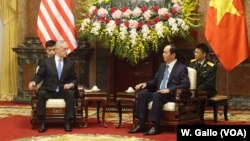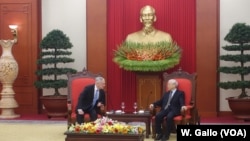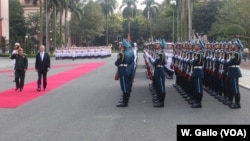Defense Secretary Jim Mattis praised the expected visit of a U.S. aircraft carrier to Vietnam, as he wrapped up a visit to Hanoi Thursday.
“We thank you for the increasing partnership, with our carrier coming into Danang here in March,” Mattis told Vietnam’s Communist Party chief, Nguyen Phu Trong.
The carrier visit, the first of its kind to a Vietnamese port, would be a tangible sign of expanding military ties between the former war-time enemies.
Pentagon officials stress that Vietnam’s prime minister, its official head of state, has the final sign-off on a U.S. carrier visit.
“It’s not final, but it all looked very encouraging,” Mattis later told reporters.
The U.S. has moved closer to Vietnam, especially as Hanoi has become more willing to stand up to China’s disputed territorial claims in the South China Sea.
“We think it’s in America’s best interest to see a strong and prosperous and independent Vietnam, and we intend to be a partner as we go forward,” Mattis said.
Healing a troubled past
Mattis’ visit comes days ahead of the 50th anniversary of the Tet Offensive, one of the largest campaigns of the U.S.-Vietnam war and a reminder of the countries’ troubled history.
“We’re still working on removing, remediating the effects of the war,” Mattis acknowledged. “We respect the past, but it was definitely a forward-looking (visit).”
In his public comments throughout the visit, Mattis emphasized areas of agreement.
But reminders of political differences were never far away in a country led by a single-party, Communist government.
When Mattis reviewed honor guard troops at the Vietnamese defense ministry, he did so in front of buildings decorated with hammers and sickles.
When he gave joint statements with Vietnamese leaders, he spoke under the gaze of towering, bronze statues of Ho Chi Minh, Vietnam’s war-time leader.
While such imagery may have been inevitable in a Communist-led country, it was especially notable given Mattis’ repeated focus on common ground.
“We are like-minded partners,” Mattis told Communist Party General Secretary Nguyen. “So we do not have to search hard for areas of common agreement.”
On the plane ride out of Hanoi, Mattis referenced the “shared values” of both countries.
South China Sea
Those values, he noted, include support for freedom of navigation and the rule of law in the South China Sea.
Beijing claims nearly the entire South China Sea, ignoring the claims of many of its smaller neighbors.
Since Vietnam has a policy of no alliances, U.S. officials are cautious about the pace of improving relations. But Mattis said ties are “close now, and getting closer.”
The U.S. recently transferred a Hamilton-class cutter to Vietnam’s Coast Guard. That ship, the largest ship in the country’s coast guard or navy, was the first U.S. transfer of lethal military equipment to Vietnam.
In 2016, then-President Barack Obama lifted a decades-old embargo on U.S. weapons sales to Vietnam. The U.S. currently has 24 active foreign military sales with Vietnam, valued around $70 million, according to U.S. officials.
An expanded relationship with Southeast Asian allies could play a role in the Pentagon’s new defense strategy, which attempts to refocus U.S. attention on a geopolitical rivalry with China and Russia.
Vietnam has an increasing capability to stand up to China and offer an “increasingly credible deterrent,” said Carl Thayer, emeritus professor with Australia’s University of New South Wales-Canberra.
“In the event of a minor flare-up, China can’t just expect to walk away and bloody Vietnam’s nose without ... suffering some damage to itself,” Thayer said.












